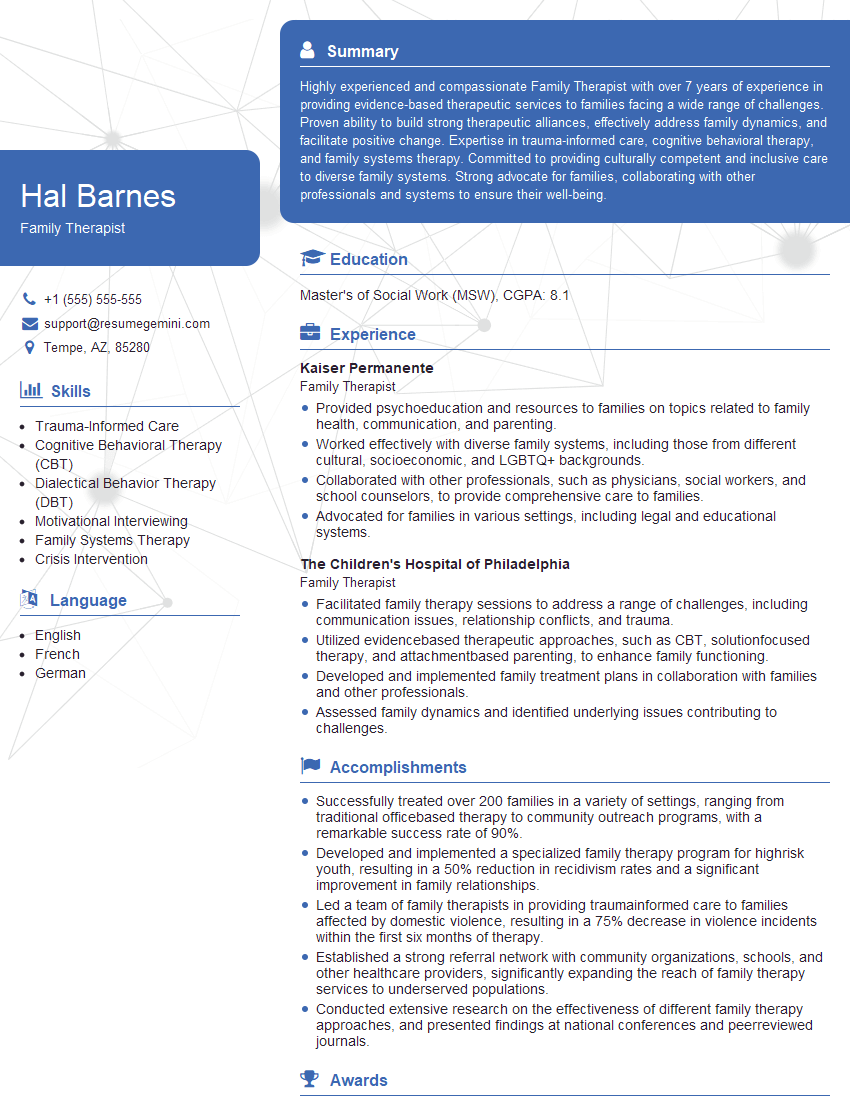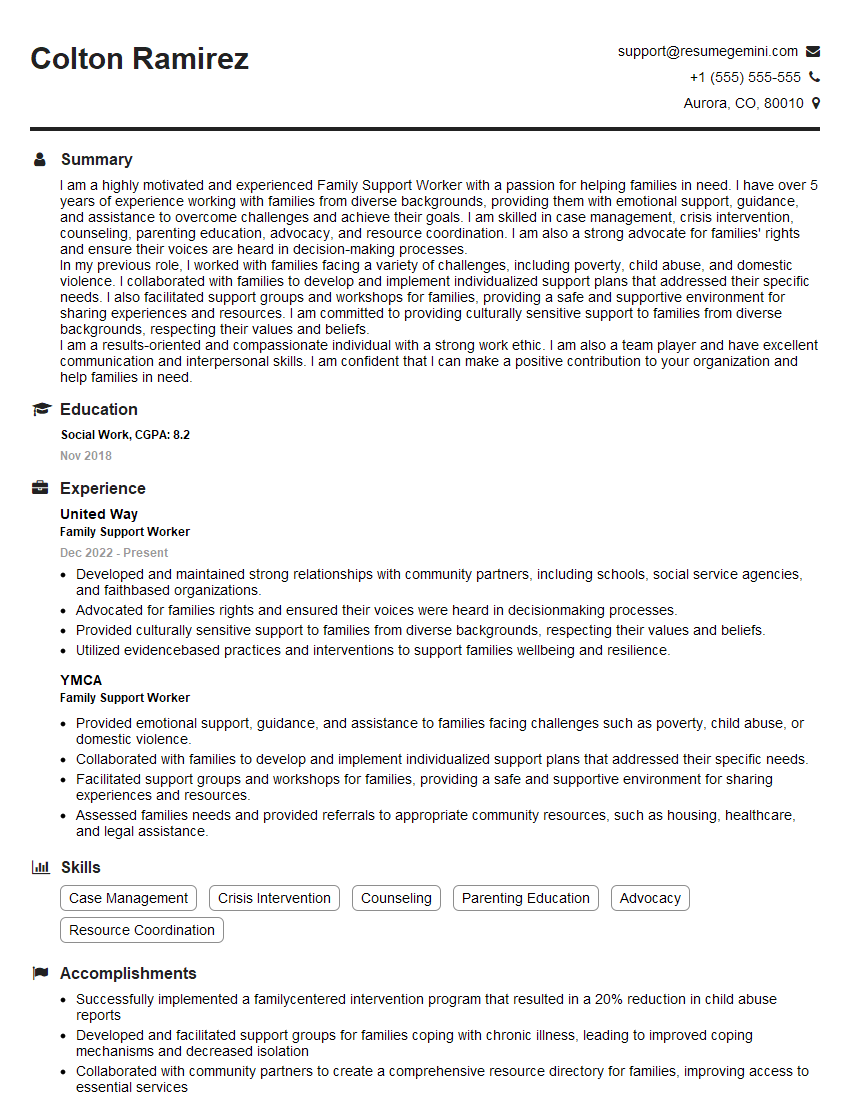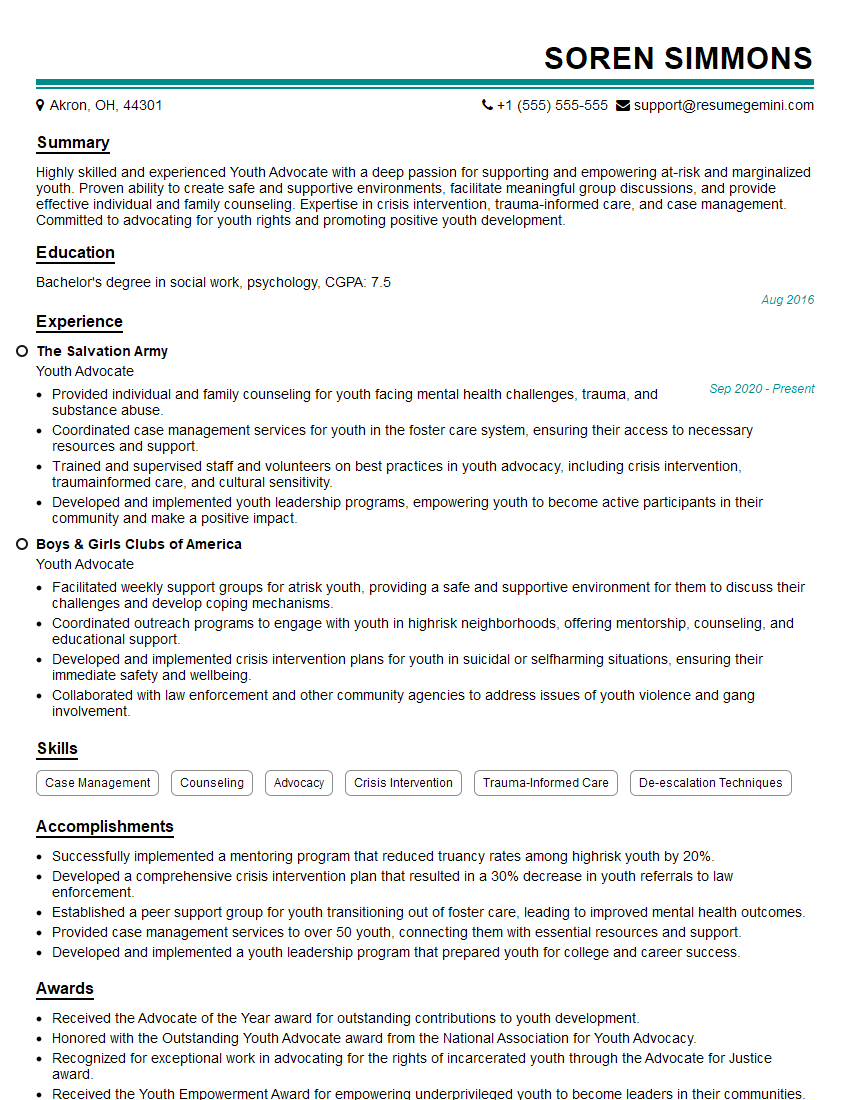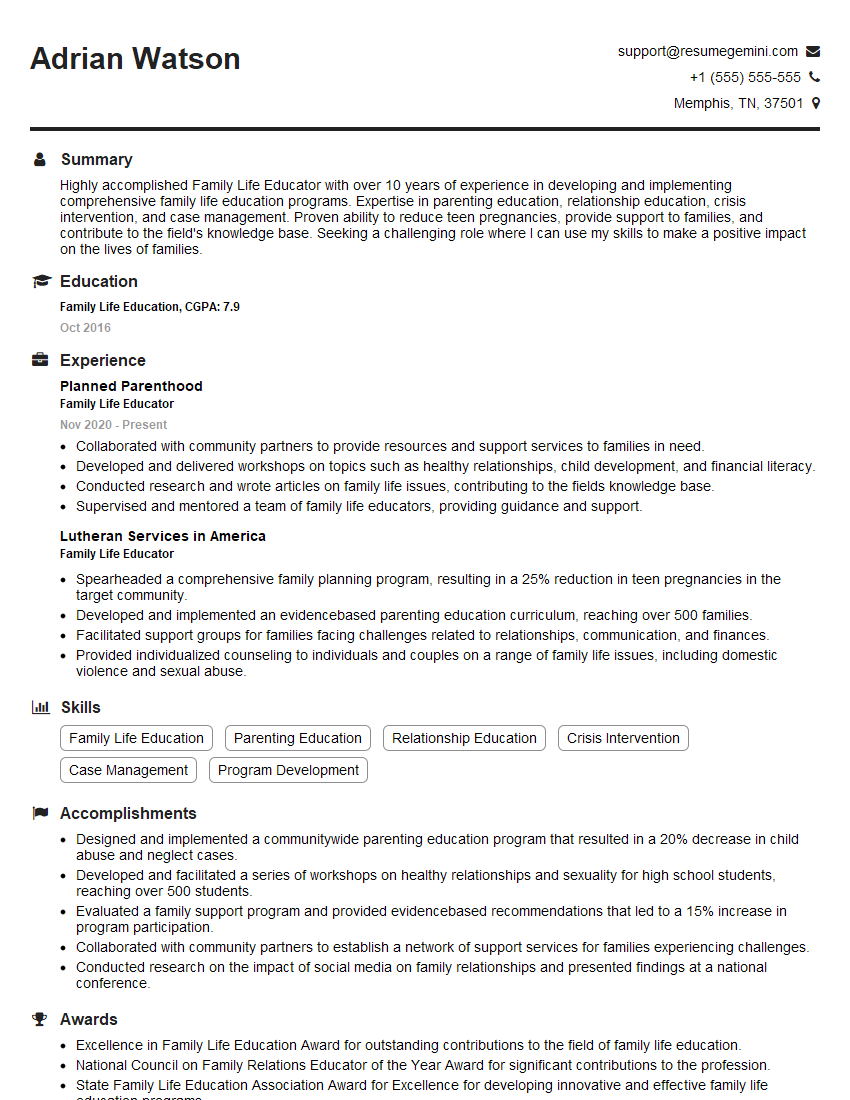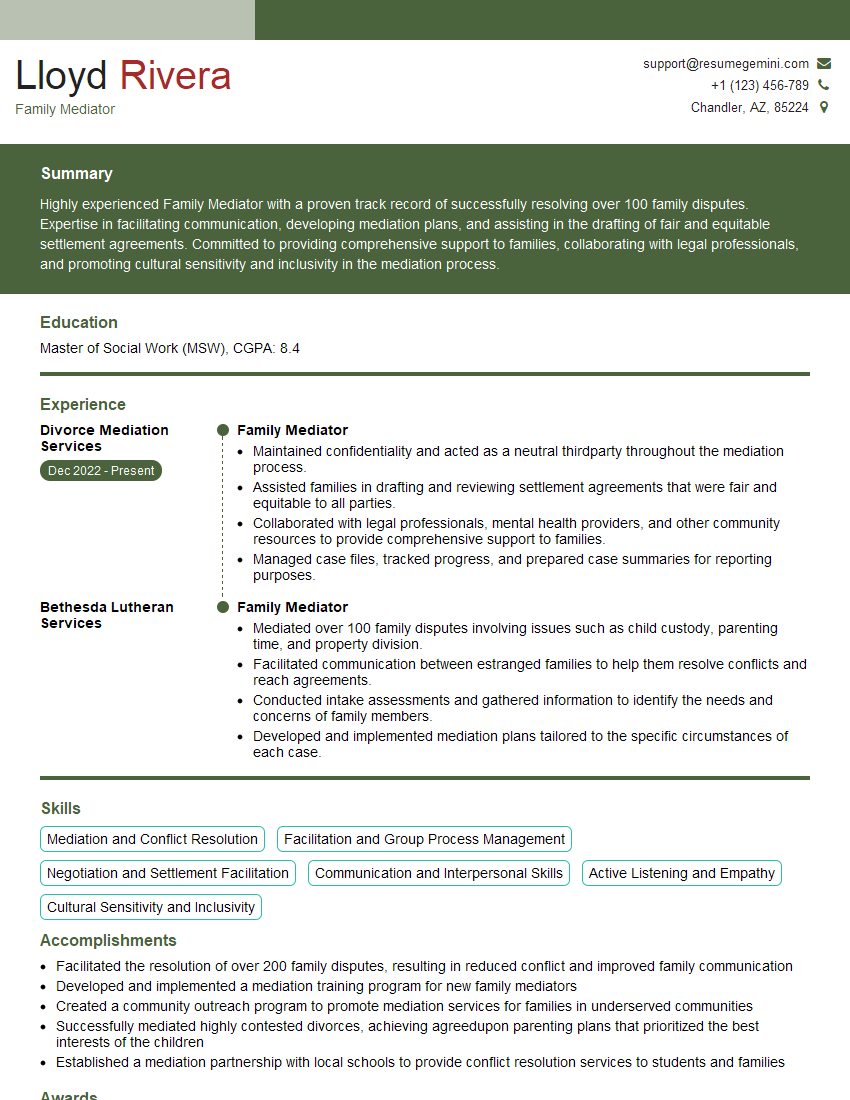Unlock your full potential by mastering the most common Family Collaboration interview questions. This blog offers a deep dive into the critical topics, ensuring you’re not only prepared to answer but to excel. With these insights, you’ll approach your interview with clarity and confidence.
Questions Asked in Family Collaboration Interview
Q 1. Describe your experience implementing family-centered practices.
My experience implementing family-centered practices spans over ten years, working with diverse families facing various challenges. I’ve consistently prioritized building strong therapeutic alliances based on mutual respect, trust, and shared decision-making. This involved actively listening to families’ concerns, understanding their unique cultural contexts, and collaborating with them to develop individualized plans. For instance, I worked with a family struggling with a child’s behavioral issues. Instead of imposing solutions, we collaboratively identified their strengths and challenges, leading to a plan that empowered the parents and improved the child’s behavior. This plan integrated family routines and cultural practices, proving more effective than a generic approach.
This also includes incorporating strengths-based perspectives, focusing not only on challenges but also on family resources and resilience. I’ve developed and facilitated numerous workshops on family communication, conflict resolution, and parenting skills tailored to the specific needs of the families involved. Success for me is not just about achieving specific outcomes, but also about building family capacity and empowering families to navigate future challenges independently.
Q 2. Explain your understanding of family systems theory.
Family systems theory posits that a family is a complex interconnected system where each member influences and is influenced by others. Understanding this interdependence is crucial. Changes in one part of the system inevitably impact other parts. For example, a child’s academic struggles might reflect underlying family conflicts or communication breakdowns. This theory highlights several key concepts:
- Circular Causality: Problems are not linear but cyclical, with each member contributing to the issue. Blaming a single individual is unproductive.
- Boundaries: Healthy families maintain clear but flexible boundaries between members, promoting both individuality and connection.
- Subsystem Dynamics: Families have various subsystems (e.g., parent-child, sibling dyads) with their own interactions and rules.
- Homeostasis: Families strive for balance and equilibrium. Change can be resisted if it disrupts this balance.
Applying this in practice means focusing not just on the presenting problem but also on the family’s overall dynamic and interaction patterns. Intervention might focus on improving communication patterns, strengthening boundaries, or adjusting subsystem interactions to achieve a more balanced and functional family system.
Q 3. How do you build rapport and trust with families from diverse backgrounds?
Building rapport and trust with diverse families requires cultural humility and sensitivity. It’s crucial to avoid stereotypes and approach each family with an open mind. I prioritize active listening, demonstrating genuine interest in their experiences and perspectives. This involves asking open-ended questions, reflecting back what I hear, and showing empathy. I adapt my communication style to meet their preferences and cultural norms. For example, understanding preferred communication styles (direct vs. indirect) significantly impacts the process.
Moreover, I collaborate with community resources and interpreters, as needed, ensuring accessibility and inclusivity. I value self-reflection and continuous learning about different cultural practices and beliefs, recognizing my own cultural biases and potential limitations. Building strong relationships requires time, trust, and the commitment to create a safe and non-judgmental space where families feel comfortable sharing their stories.
Q 4. Describe a time you had to mediate conflict within a family.
I once worked with a family experiencing significant conflict around childcare responsibilities following a divorce. The parents’ communication was highly charged and accusatory, creating a highly stressful environment for their two children. I facilitated a series of family meetings using a collaborative approach. I started by establishing ground rules for respectful communication and actively listening to each member’s perspective. I didn’t take sides, instead focusing on helping them identify shared goals – primarily, the well-being of their children.
Step-by-step, we explored practical solutions using a structured approach: We brainstormed various childcare arrangements, then evaluated their feasibility based on each parent’s schedule and resources. We also addressed underlying emotional issues impacting their interaction. The process was gradual, with periodic check-ins. The parents ultimately reached a mutually agreeable arrangement, reducing their conflict and significantly improving their family environment.
Q 5. How do you identify and address power imbalances within families?
Power imbalances manifest in families in various ways—e.g., one parent dominating decision-making, one child having disproportionate influence, or cultural expectations favoring certain family members. Identifying these imbalances requires careful observation of family dynamics and communication patterns. I actively look for patterns like consistent interruptions, dismissing others’ opinions, or unequal distribution of responsibilities. I’ll also inquire about family rules and decision-making processes.
Addressing these imbalances involves empowering marginalized members. This might involve creating opportunities for them to express their needs, facilitating equal participation in family discussions, or challenging culturally ingrained power dynamics. For example, I might work with a family where a patriarchal structure consistently silences the mother’s voice. I’d create opportunities for her to express her needs and perspectives, model respectful communication, and advocate for her inclusion in family decision-making.
Q 6. What strategies do you use to facilitate effective communication within families?
Facilitating effective communication involves teaching active listening, assertive communication, and conflict resolution skills. I use techniques such as “I” statements to encourage expressing feelings without blame, and reflective listening to ensure mutual understanding. I provide structured communication exercises to improve communication patterns. These include role-playing scenarios, practicing active listening techniques, and discussing conflict resolution strategies.
In addition, I may use visual aids or communication tools (e.g., family meetings with agendas, visual charts to track progress) particularly with younger children or families with communication challenges. It is imperative to adapt these strategies to each family’s specific needs and cultural context.
Q 7. How do you ensure family voices are heard and respected in decision-making processes?
Ensuring family voices are heard requires creating a genuinely collaborative environment. This starts with actively seeking family input in all aspects of the process. I use open-ended questions to gather their perspectives, validate their feelings, and show respect for their experiences. This involves making sure everyone understands the agenda, creating a safe space for sharing concerns, and consistently checking in to make sure every family member feels heard.
I also prioritize family-driven decision-making. This means that plans and interventions are developed collaboratively with families, aligning with their values, goals, and preferences. I consider their cultural values and beliefs in the decision-making process. This might involve empowering parents to lead family meetings, using collaborative tools (such as shared decision-making matrices) to map options, and clearly outlining the rationale and expected outcomes for any agreed-upon plan.
Q 8. Describe your experience working with families experiencing crisis situations.
Working with families in crisis requires a trauma-informed approach, prioritizing safety and stability. My experience involves navigating complex situations, such as domestic violence, child abuse, substance abuse, and severe mental health challenges. I focus on building rapport, actively listening to each family member’s perspective, and creating a safe space for emotional expression. For example, I once worked with a family facing eviction and food insecurity. By connecting them with emergency housing assistance and food banks, and empowering them to develop a short-term financial plan, we helped them regain stability. This involved not only practical support but also emotional support, helping them to manage the stress and anxiety that came with their situation. The key is to collaborate with the family to address immediate needs while simultaneously planning for long-term sustainability.
Q 9. How do you collaborate effectively with interdisciplinary teams?
Effective interdisciplinary collaboration is crucial in family work. I utilize a collaborative, strengths-based approach, fostering open communication and mutual respect among team members. This involves regular meetings, shared case documentation, and clearly defined roles and responsibilities. For instance, when working with a child exhibiting behavioral challenges, I collaborate closely with the child’s teacher, therapist, and medical professionals, ensuring a cohesive and comprehensive approach. We utilize a shared electronic platform to ensure efficient information sharing. It’s important to understand each professional’s perspective and contribution to achieve a unified plan. We regularly convene to ensure alignment and that the family remains central to the process and has an active voice.
Q 10. What are your methods for assessing family needs and strengths?
Assessing family needs and strengths employs a holistic approach that goes beyond identifying problems. I utilize a combination of methods including structured interviews, observation, and standardized assessments. For instance, a genogram can map family structure and dynamics to identify recurring patterns and challenges, while a family ecomap displays the family’s interactions with their environment. I also use strengths-based assessments like the Family Strengths Inventory to identify protective factors and resilience within the family. The process starts with the family and is co-created in collaboration with them. The crucial element is to create a framework for the family to identify their strengths and challenges which empowers them and drives solutions and strategies that they themselves will implement. Ultimately, the goal is to empower families to identify and utilize their strengths as the foundation for positive change.
Q 11. Explain your understanding of cultural competency in family collaboration.
Cultural competency is fundamental to effective family collaboration. It involves understanding and respecting the diverse cultural backgrounds, beliefs, values, and practices of families. This includes recognizing that different cultures have unique perspectives on family roles, communication styles, and problem-solving approaches. I actively seek to learn about the family’s cultural background through respectful questioning and observation. For example, I ensure that any interventions are culturally sensitive and adapted to the family’s cultural context. This might involve collaborating with interpreters or cultural brokers as needed, ensuring material and services are easily accessible and respectful of cultural norms. Failing to account for cultural differences can severely undermine a collaborative relationship.
Q 12. Describe your approach to developing individualized family support plans.
Developing individualized family support plans is a collaborative and ongoing process. It begins with a thorough assessment of family needs and strengths, followed by collaboratively establishing measurable goals that align with the family’s aspirations. The plan outlines specific strategies and interventions, including who will be responsible for each action and a timeline for implementation. Regular reviews are conducted to monitor progress, adapt the plan as needed, and celebrate successes. For example, for a family struggling with adolescent substance abuse, the plan might include individual and family therapy, parent training, and participation in support groups. The key to success is active family engagement at each stage, creating a sense of shared ownership and responsibility.
Q 13. How do you evaluate the effectiveness of family interventions?
Evaluating the effectiveness of family interventions is a crucial step. I use a mixed-methods approach, incorporating both quantitative and qualitative data. Quantitative data might include tracking changes in specific behaviors or outcomes using standardized measures. Qualitative data would come from feedback gathered through family interviews, observations, and team discussions. This holistic approach allows a complete understanding of the impact of our interventions. For example, measuring changes in family conflict resolution skills through observations and questionnaires, along with feedback from family members, gives a richer and more comprehensive understanding of outcomes. Regular progress monitoring and adjustments enable flexible, adaptive support.
Q 14. What are the ethical considerations involved in family collaboration?
Ethical considerations are paramount in family collaboration. This includes maintaining confidentiality, ensuring informed consent, respecting family autonomy, and avoiding conflicts of interest. It’s critical to prioritize the family’s well-being and avoid imposing personal biases or values. For example, ensuring all family members understand the process and their rights before participating is critical, as is maintaining strict confidentiality of sensitive information. Addressing any potential power imbalances is vital to ensure equitable collaboration and decision-making. A strong ethical framework guides every aspect of the work, ensuring client safety and wellbeing are paramount.
Q 15. How do you maintain confidentiality and privacy within family interactions?
Maintaining confidentiality and privacy in family interactions is paramount. It’s about upholding ethical and legal obligations while building trust. This involves several key strategies.
- Clear Communication from the Start: I begin by explicitly explaining what information will be shared, with whom, and why. For example, I’ll state that information shared in individual sessions will be kept confidential unless there’s a legal mandate or risk of harm.
- Consent and Permission: I always obtain informed consent before sharing any information about family members with others, even within the family itself. This means explaining the purpose of the information sharing and obtaining explicit agreement.
- Data Security: All electronic records are securely stored and accessed only by authorized personnel. Physical files are kept in locked cabinets. I’m compliant with all relevant data protection regulations.
- Boundaries and Roles: I clearly define my role as a facilitator and not a judge or decision-maker. This helps maintain neutrality and protects the privacy of individual family members.
- Addressing Disclosure Concerns: If a family member expresses concern about confidentiality, I address their worries directly and work to alleviate their anxieties. This might involve clarifying procedures or offering reassurance.
For instance, in a case involving a teenager disclosing substance abuse, I’d assure them that their confidentiality would be maintained, except in situations where there is an immediate risk of harm to themselves or others – this would be clearly articulated upfront.
Career Expert Tips:
- Ace those interviews! Prepare effectively by reviewing the Top 50 Most Common Interview Questions on ResumeGemini.
- Navigate your job search with confidence! Explore a wide range of Career Tips on ResumeGemini. Learn about common challenges and recommendations to overcome them.
- Craft the perfect resume! Master the Art of Resume Writing with ResumeGemini’s guide. Showcase your unique qualifications and achievements effectively.
- Don’t miss out on holiday savings! Build your dream resume with ResumeGemini’s ATS optimized templates.
Q 16. How do you adapt your communication style to different family dynamics?
Adapting communication style to diverse family dynamics is crucial for effective collaboration. Families differ significantly in their communication patterns, power structures, and cultural backgrounds.
- Observational Assessment: I begin by observing family interactions to understand their communication styles – are they direct or indirect? Do they prefer emotional expression or factual statements? Is there a dominant figure?
- Active Listening: I focus on actively listening to understand each family member’s perspective, using reflective listening techniques to ensure understanding.
- Tailoring Language: I adapt my vocabulary and tone to suit the family’s comfort level. I avoid jargon and use clear, concise language.
- Respecting Cultural Differences: I’m mindful of cultural norms and communication styles that might influence interactions. For example, some cultures value indirect communication, while others are more direct.
- Addressing Power Dynamics: I pay attention to power imbalances within the family and work to create a safe space where all members feel comfortable expressing themselves.
For instance, with a family where one parent is clearly dominant, I would intentionally solicit input from all members, including the quieter ones, to ensure everyone feels heard. With a family from a culture that values indirect communication, I might use more open-ended questions and pay close attention to nonverbal cues.
Q 17. Describe a time you had to manage conflict between family members and professionals.
In one case, I had to mediate a conflict between a family grappling with a child’s severe behavioral issues and their therapist. The therapist felt the family wasn’t consistently implementing the recommended treatment plan, while the family felt overwhelmed and misunderstood.
My approach involved:
- Separate Conversations: I first met individually with the family and the therapist to understand their respective perspectives and concerns without judgment.
- Joint Meeting: Then, I facilitated a joint meeting where each party could express their concerns openly and respectfully. I actively listened and helped reframe their statements to focus on shared goals.
- Collaborative Problem-Solving: I guided them towards collaborative problem-solving by focusing on specific, actionable steps. We adjusted the treatment plan to address the family’s needs and capacity.
- Ongoing Support: Following the meeting, I provided ongoing support and check-ins to help maintain communication and address any new challenges.
The key was creating a safe space for open communication and helping everyone understand each other’s perspectives. Through collaborative problem-solving, we found a workable plan that addressed the child’s needs and supported the family’s well-being.
Q 18. How do you address resistance from family members to intervention strategies?
Resistance to intervention strategies is common. Addressing this requires empathy, understanding, and a collaborative approach.
- Understanding Resistance: First, I explore the reasons behind the resistance. Is it due to fear, mistrust, lack of understanding, cultural differences, or perceived loss of control?
- Building Rapport: Building trust and rapport with family members is key. This takes time, active listening, and demonstrating genuine concern for their well-being.
- Collaboration and Empowerment: I work collaboratively with the family, ensuring they feel empowered to participate in shaping the intervention strategy. I avoid a top-down approach.
- Addressing Concerns: I openly address their concerns and anxieties, providing clear explanations and answering questions honestly. I offer alternative options if appropriate.
- Small Steps and Gradual Change: Instead of imposing drastic changes, I often suggest starting with small, manageable steps that build confidence and momentum.
For example, if a family is resistant to family therapy, I might suggest starting with individual sessions to build trust before transitioning to family sessions. I might also offer educational materials to increase their understanding of the intervention.
Q 19. Explain your understanding of trauma-informed care in a family context.
Trauma-informed care in a family context prioritizes understanding the impact of trauma on each family member and the family system as a whole. It recognizes that trauma can significantly affect relationships, communication, and behavior.
- Safety and Trust: Creating a safe and supportive environment where family members feel heard, understood, and respected is paramount.
- Understanding Trauma’s Impact: I assess the types and impact of traumas experienced by each family member, recognizing that trauma can manifest differently.
- Collaboration and Empowerment: I involve the family in the process of designing and implementing strategies. Empowerment is central to healing.
- Strengths-Based Approach: I focus on the family’s strengths and resilience, recognizing that trauma does not define them.
- Culturally Sensitive Care: I account for the family’s cultural context and beliefs, understanding that trauma can manifest differently across cultures.
A trauma-informed approach might involve using techniques like mindfulness, relaxation exercises, or narrative therapy to help family members process their trauma and rebuild their relationships. It also means avoiding triggering situations or language and providing resources for continued support.
Q 20. Describe your experience using technology to support family collaboration.
Technology plays a vital role in supporting family collaboration. Secure video conferencing platforms allow for convenient and accessible family meetings, especially for geographically dispersed families.
- Video Conferencing: Platforms like Zoom or Microsoft Teams provide opportunities for regular family sessions, regardless of location. This enhances accessibility and reduces barriers to participation.
- Secure Messaging: Encrypted messaging apps allow for private communication between family members and myself, maintaining confidentiality. This is useful for quick questions or updates between sessions.
- Online Resources: I might use online resources and educational materials to support family learning and engagement. This could include links to articles, videos, or interactive exercises.
- Data Management: Secure online platforms for storing and accessing case notes and other relevant documents improve organization and accessibility.
For example, I utilize a secure video conferencing platform to conduct family sessions, which allows family members who live in different states to easily participate. I also share relevant articles and resources online to support the family’s learning process.
Q 21. How do you navigate legal and regulatory requirements when working with families?
Navigating legal and regulatory requirements is essential when working with families. This involves understanding and adhering to laws related to confidentiality, child protection, and data privacy.
- Confidentiality: I am bound by professional ethics and legal obligations regarding confidentiality. Exceptions exist in cases of mandated reporting (e.g., child abuse or neglect) or when there’s a serious risk of harm.
- Child Protection: I am knowledgeable about child protection laws and procedures. If there are concerns about a child’s safety, I’m obligated to follow mandated reporting procedures.
- Data Privacy: I comply with all relevant data privacy regulations, such as HIPAA (in the US) or GDPR (in Europe), ensuring secure storage and handling of sensitive information.
- Informed Consent: I ensure that all family members understand their rights and provide informed consent for services and information sharing.
- Professional Boundaries: I maintain strict professional boundaries and avoid conflicts of interest.
For instance, if a family member discloses information that suggests a child is being neglected, I am legally obligated to report this to the relevant authorities. I would explain this to the family, emphasizing my ethical and legal responsibilities while assuring them of my commitment to their well-being.
Q 22. How do you handle situations where family members disagree about intervention approaches?
Disagreements about intervention approaches are common in family collaboration. My approach prioritizes understanding each family member’s perspective and finding common ground. I facilitate open dialogue, ensuring everyone feels heard and respected. This involves active listening, empathetic questioning, and reframing conflicting viewpoints to highlight shared goals. For instance, if one family member advocates for strict discipline while another prefers a more lenient approach, I’d guide them towards discussing the underlying concerns – like the child’s behavior or safety – rather than focusing on the methods themselves. We then collaboratively explore alternative strategies that address those concerns, accommodating varying preferences where possible. The process often involves compromise and creating a plan that everyone feels comfortable supporting, even if it’s not exactly what they initially envisioned.
Sometimes, professional intervention may be needed. In such cases, I work with other professionals (e.g., therapists, child protection services) to ensure a unified and holistic approach that respects the family’s autonomy and cultural context.
Q 23. How do you measure success in family collaboration work?
Measuring success in family collaboration is multifaceted and goes beyond simply achieving a specific outcome. It’s about observing positive changes in family dynamics and well-being over time. I use a combination of qualitative and quantitative methods. Quantitative measures might include tracking attendance at family meetings, participation in planned activities, or improvements in specific behavioral indicators (e.g., reduction in conflict, improved communication). However, equally important are qualitative indicators, such as improved family communication, increased trust and cohesion, enhanced problem-solving skills, and a sense of shared responsibility. I regularly conduct feedback sessions with the family to gauge their perceptions of progress and satisfaction. For example, increased expressions of affection, collaborative conflict resolution, and the family’s ability to navigate challenges independently are key indicators of success.
Q 24. What are some common challenges you face in family collaboration, and how do you overcome them?
Common challenges in family collaboration include communication barriers, power imbalances, past trauma impacting trust, and differing cultural perspectives. I overcome these by employing culturally sensitive approaches, building rapport with each family member individually, and establishing clear communication protocols. For example, if language barriers exist, I utilize interpreters or translators. To address power imbalances, I create a safe and inclusive environment where everyone’s voice is valued. Addressing past trauma requires a sensitive approach, potentially involving referral to specialized trauma-informed therapists. Finally, acknowledging and respecting cultural differences is crucial, requiring ongoing learning and adapting my strategies to fit the family’s unique context.
- Communication barriers: Using clear and simple language, active listening, and visual aids.
- Power imbalances: Creating an egalitarian setting, empowering quieter voices, and mediating disputes fairly.
- Trauma: Building trust gradually, creating a safe space, and referring to trauma-informed professionals when necessary.
- Cultural differences: Seeking cultural sensitivity training, adapting approaches to suit diverse family norms and values.
Q 25. Describe your experience with crisis intervention within families.
Crisis intervention within families requires immediate action to ensure safety and stability. My approach prioritizes assessing the immediate risk, providing support to stabilize the situation, and developing a short-term safety plan. This involves working collaboratively with the family to identify the triggers and contributing factors to the crisis, and then empowering them to develop strategies to prevent future occurrences. For instance, if a family is experiencing domestic violence, the immediate priority is ensuring the safety of all family members, often involving collaboration with law enforcement and protective services. Following the immediate crisis, I work with the family to develop a safety plan that includes emergency contacts, escape routes, and strategies for de-escalating conflict. This work often involves ongoing support and referral to specialized services.
Q 26. How do you ensure sustainability and long-term family well-being after intervention ends?
Sustainability is paramount. After intervention concludes, I work with the family to develop a transition plan that gradually reduces my direct involvement. This includes empowering family members to take ownership of their solutions, strengthening their coping mechanisms, and connecting them with community resources that can provide ongoing support. This might involve connecting them to support groups, mentoring programs, or ongoing therapy. Regular follow-up sessions provide a way to check in on their progress and provide additional support if needed. Moreover, creating a strong support network within the family itself, by building collaborative problem-solving skills, increases their capacity for long-term well-being.
Q 27. Describe your knowledge of relevant legislation impacting families.
My knowledge of relevant legislation impacting families is extensive and includes, but is not limited to, laws related to child protection, domestic violence, family law, and disability rights. This includes understanding reporting requirements for child abuse and neglect, legal processes surrounding divorce and custody arrangements, and access to services for families with disabilities. I stay updated on changes in legislation and ensure my practice aligns with the current legal framework. This includes being aware of the legal rights and responsibilities of family members, as well as the legal parameters within which I can offer support and intervention.
Q 28. How do you maintain your own well-being while working with challenging family situations?
Working with challenging family situations can be emotionally demanding. To maintain my well-being, I prioritize self-care practices such as regular exercise, mindfulness techniques, and engaging in hobbies outside of work. I also have a strong support network of colleagues and supervisors who I can discuss challenging cases with. Regular supervision sessions provide a space to process complex emotions, reflect on my practice, and receive guidance on navigating challenging ethical dilemmas. Furthermore, recognizing my personal limitations and seeking additional support when needed are crucial in preventing burnout and maintaining a sustainable practice.
Key Topics to Learn for Family Collaboration Interview
- Understanding Family Systems Theory: Grasping core concepts like boundaries, roles, and hierarchies within families, and their impact on conflict resolution and collaborative processes.
- Communication and Conflict Resolution Strategies: Developing skills in active listening, empathy, and effective communication techniques for navigating disagreements and finding mutually acceptable solutions within families. This includes understanding different communication styles and adapting approaches accordingly.
- Ethical Considerations in Family Collaboration: Familiarizing yourself with ethical dilemmas and best practices related to confidentiality, informed consent, and power dynamics within family settings. Knowing how to navigate challenging situations ethically is crucial.
- Practical Application in Diverse Family Structures: Demonstrating understanding of how family collaboration principles apply across different family structures (e.g., single-parent families, blended families, multi-generational families) and cultural contexts.
- Assessment and Intervention Techniques: Understanding various assessment tools and intervention strategies used to facilitate family collaboration, such as mediation, negotiation, and other collaborative approaches. Being able to describe specific techniques and their practical applications is valuable.
- Collaboration with Other Professionals: Understanding the importance of and processes for effective collaboration with other professionals, such as therapists, social workers, and legal representatives, within a family support system.
Next Steps
Mastering Family Collaboration opens doors to rewarding careers offering significant impact on individuals and families. To stand out, create an ATS-friendly resume that showcases your skills and experience effectively. ResumeGemini is a trusted resource to help you build a professional resume that highlights your strengths and gets noticed by recruiters. Examples of resumes tailored to Family Collaboration are available, allowing you to craft a compelling application that demonstrates your expertise.
Explore more articles
Users Rating of Our Blogs
Share Your Experience
We value your feedback! Please rate our content and share your thoughts (optional).
What Readers Say About Our Blog
Hi, I’m Jay, we have a few potential clients that are interested in your services, thought you might be a good fit. I’d love to talk about the details, when do you have time to talk?
Best,
Jay
Founder | CEO
